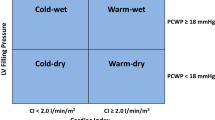Abstract
Purpose
Pulmonary artery hypertension is correlated with poor clinical prognosis in patients with chronic heart failure. However, there is a paucity of data concerning the impact of baseline pulmonary artery systolic pressure (PASP) on clinical outcome after cardiac resynchronization therapy (CRT). The aim of the study is to evaluate the association of baseline PASP with CRT response.
Methods
One hundred eighty-seven consecutive patients undergoing CRT were screened for retrospective analysis. Patients were stratified into three groups based on preoperative PASP which was determined by echocardiogram (group I, PASP < 45 mmHg; group II, 45 mmHg ≤ PASP < 70 mmHg; and group III, PASP ≥ 70 mmHg). Clinical and echocardiographic improvements, as well as the response rate, were assessed 6 months after CRT. Long-term prognosis, measured as transplantation- and hospitalization-free survival, was also compared across the three groups.
Results
One hundred eighty-three patients were evaluated with a mean age of 60.7 ± 11.2 years. At 6-month follow-up, patients in group I demonstrated greater clinical improvements (p < 0.05) and higher response rate (p < 0.01) than groups II and III. Compared with group I, death or transplantation was significantly more often noted in group II (hazard ratio, 4.89; 95 % CI, 1.53–15.60; p = 0.007) and group III (hazard ratio, 5.91; 95 % CI, 1.25–27.94; p = 0.025) as was heart failure readmission for group II (hazard ratio, 2.48; 95 % CI, 1.24–4.98; p = 0.011) and group III (hazard ratio, 6.39; 95 % CI, 2.26–18.06; p < 0.001).
Conclusions
Patients with elevated PASP derive less benefit from CRT. Baseline PASP could serve as an independent predictor for long-term prognosis.



Similar content being viewed by others
References
Bristow, M. R., Saxon, L. A., Boehmer, J., Krueger, S., Kass, D. A., De Marco, T., et al. (2004). Cardiac-resynchronization therapy with or without an implantable defibrillator in advanced chronic heart failure. New England Journal of Medicine, 350(21), 2140–2150.
Cleland, J. G., Daubert, J. C., Erdmann, E., Freemantle, N., Gras, D., Kappenberger, L., et al. (2005). The effect of cardiac resynchronization on morbidity and mortality in heart failure. New England Journal of Medicine, 352(15), 1539–1549.
Díaz-Infante, E., Mont, L., Leal, J., García-Bolao, I., Fernández-Lozano, I., Hernández-Madrid, A., et al. (2005). Predictors of lack of response to resynchronization therapy. American Journal of Cardiology, 95(12), 1436–1440.
Ghio, S., Gavazzi, A., Campana, C., Inserra, C., Klersy, C., Sebastiani, R., et al. (2001). Independent and additive prognostic value of right ventricular systolic function and pulmonary artery pressure in patients with chronic heart failure. Journal of the American College of Cardiology, 37(1), 183–188.
Schiller, N. B., Shah, P. M., Crawford, M., DeMaria, A., Devereux, R., Feigenbaum, H., et al. (1989). Recommendations for quantitation of the left ventricle by two-dimensional echocardiography. American Society of Echocardiography Committee on Standards, Subcommittee on Quantitation of Two-Dimensional Echocardiograms. Journal of the American Society of Echocardiography, 2(2), 358–367.
Bleeker, G. B., Bax, J. J., Fung, J. W., van der Wall, E. E., Zhang, Q., Schalij, M. J., et al. (2006). Clinical versus echocardiographic parameters to assess response to cardiac resynchronization therapy. American Journal of Cardiology, 97(2), 260–263.
Berger, M., Haimowitz, A., Van Tosh, A., Berdoff, R. L., & Goldberg, E. (1985). Quantitative assessment of pulmonary hypertension in patients with tricuspid regurgitation using continuous wave Doppler ultrasound. Journal of the American College of Cardiology, 6(2), 359–365.
Shalaby, A., Voigt, A., El-Saed, A., & Saba, S. (2008). Usefulness of pulmonary artery pressure by echocardiography to predict outcome in patients receiving cardiac resynchronization therapy heart failure. American Journal of Cardiology, 101(2), 238–241.
Rudski, L. G., Lai, W. W., Afilalo, J., Hua, L., Handschumacher, M. D., & Chandrasekaran, K. (2010). Guidelines for the echocardiographic assessment of the right heart in adults: a report from the American Society of Echocardiography endorsed by the European Association of Echocardiography, a registered branch of the European Society of Cardiology, and the Canadian Society of Echocardiography. Journal of the American Society of Echocardiography, 23(7), 685–713.
Stern, J., Heist, E. K., Murray, L., Alabiad, C., Chung, J., Picard, M. H., et al. (2007). Elevated estimated pulmonary artery systolic pressure is associated with an adverse clinical outcome in patients receiving cardiac resynchronization therapy. Pacing and Clinical Electrophysiology, 30(5), 603–607.
Wang, D., Han, Y., Zang, H., Yu, H., Wang, S., Wang, Z., et al. (2010). Prognostic effects of pulmonary hypertension in patients undergoing cardiac resynchronization therapy. Journal of Thoracic and Diseases, 2(2), 71–75.
Boissiere, J., Gautier, M., Machet, M. C., Hanton, G., Bonnet, P., & Eder, V. (2005). Doppler tissue imaging in assessment of pulmonary hypertension-induced right ventricle dysfunction. American Journal of Physiology-Heart and Circulatory Physiology, 289(6), H2450–H2455.
Conflict of interest
No conflict of interest exists.
Author information
Authors and Affiliations
Corresponding author
Additional information
Jingfeng Wang and Yangang Su share first authorship.
Rights and permissions
About this article
Cite this article
Wang, J., Su, Y., Bai, J. et al. Elevated pulmonary artery pressure predicts poor outcome after cardiac resynchronization therapy. J Interv Card Electrophysiol 40, 171–178 (2014). https://doi.org/10.1007/s10840-014-9890-2
Received:
Accepted:
Published:
Issue Date:
DOI: https://doi.org/10.1007/s10840-014-9890-2




